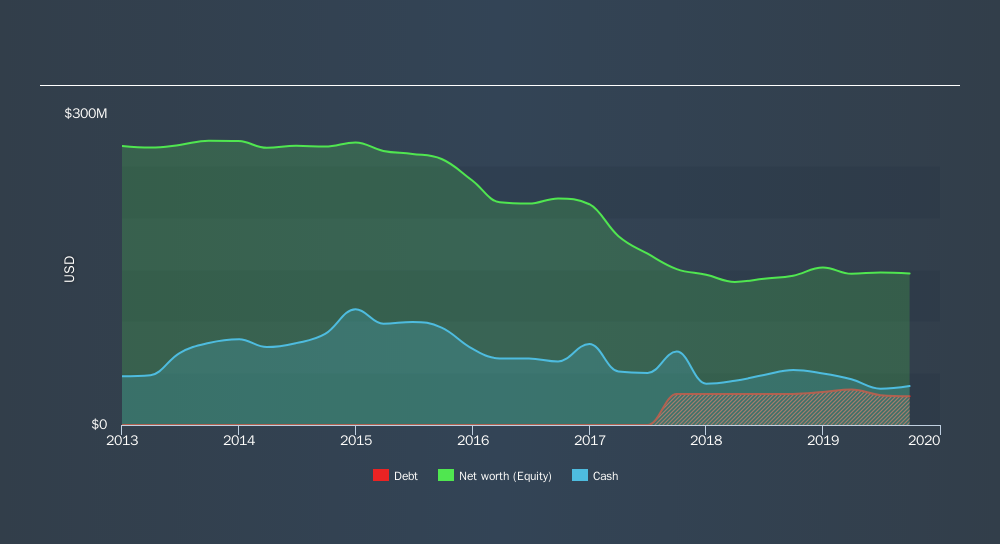
Howard Marks put it nicely when he said that, rather than worrying about share price volatility, 'The possibility of permanent loss is the risk I worry about... and every practical investor I know worries about. So it might be obvious that you need to consider debt, when you think about how risky any given stock is, because too much debt can sink a company. We can see that Calix, Inc. (NYSE:CALX) does use debt in its business. But the real question is whether this debt is making the company risky.
When Is Debt A Problem?
Debt and other liabilities become risky for a business when it cannot easily fulfill those obligations, either with free cash flow or by raising capital at an attractive price. Ultimately, if the company can't fulfill its legal obligations to repay debt, shareholders could walk away with nothing. While that is not too common, we often do see indebted companies permanently diluting shareholders because lenders force them to raise capital at a distressed price. By replacing dilution, though, debt can be an extremely good tool for businesses that need capital to invest in growth at high rates of return. The first thing to do when considering how much debt a business uses is to look at its cash and debt together.
View our latest analysis for Calix
What Is Calix's Debt?
You can click the graphic below for the historical numbers, but it shows that Calix had US$27.7m of debt in September 2019, down from US$30.0m, one year before. However, its balance sheet shows it holds US$37.6m in cash, so it actually has US$9.86m net cash.

How Healthy Is Calix's Balance Sheet?
The latest balance sheet data shows that Calix had liabilities of US$123.6m due within a year, and liabilities of US$46.7m falling due after that. On the other hand, it had cash of US$37.6m and US$48.5m worth of receivables due within a year. So it has liabilities totalling US$84.3m more than its cash and near-term receivables, combined.
Calix has a market capitalization of US$420.6m, so it could very likely raise cash to ameliorate its balance sheet, if the need arose. But we definitely want to keep our eyes open to indications that its debt is bringing too much risk. Despite its noteworthy liabilities, Calix boasts net cash, so it's fair to say it does not have a heavy debt load! There's no doubt that we learn most about debt from the balance sheet. But ultimately the future profitability of the business will decide if Calix can strengthen its balance sheet over time. So if you're focused on the future you can check out this free report showing analyst profit forecasts.
Over 12 months, Calix made a loss at the EBIT level, and saw its revenue drop to US$420m, which is a fall of 9.5%. That's not what we would hope to see.
So How Risky Is Calix?
Statistically speaking companies that lose money are riskier than those that make money. And we do note that Calix had negative earnings before interest and tax (EBIT), over the last year. And over the same period it saw negative free cash outflow of US$15m and booked a US$24m accounting loss. However, it has net cash of US$9.86m, so it has a bit of time before it will need more capital. Overall, we'd say the stock is a bit risky, and we're usually very cautious until we see positive free cash flow. For riskier companies like Calix I always like to keep an eye on whether insiders are buying or selling. So click here if you want to find out for yourself.
When all is said and done, sometimes its easier to focus on companies that don't even need debt. Readers can access a list of growth stocks with zero net debt 100% free, right now.
If you spot an error that warrants correction, please contact the editor at editorial-team@simplywallst.com. This article by Simply Wall St is general in nature. It does not constitute a recommendation to buy or sell any stock, and does not take account of your objectives, or your financial situation. Simply Wall St has no position in the stocks mentioned.
We aim to bring you long-term focused research analysis driven by fundamental data. Note that our analysis may not factor in the latest price-sensitive company announcements or qualitative material. Thank you for reading.
About NYSE:CALX
Calix
Provides cloud and software platforms, and systems and services in the United States, rest of Americas, Europe, the Middle East, Africa, and the Asia Pacific.
Flawless balance sheet with reasonable growth potential.
Similar Companies
Market Insights
Community Narratives





